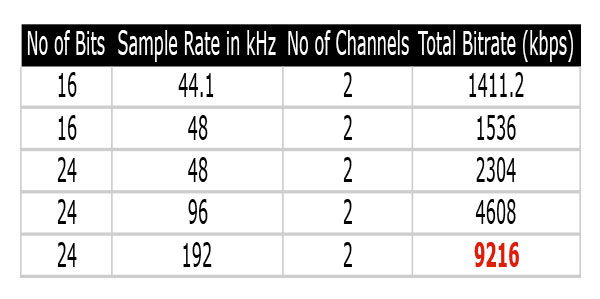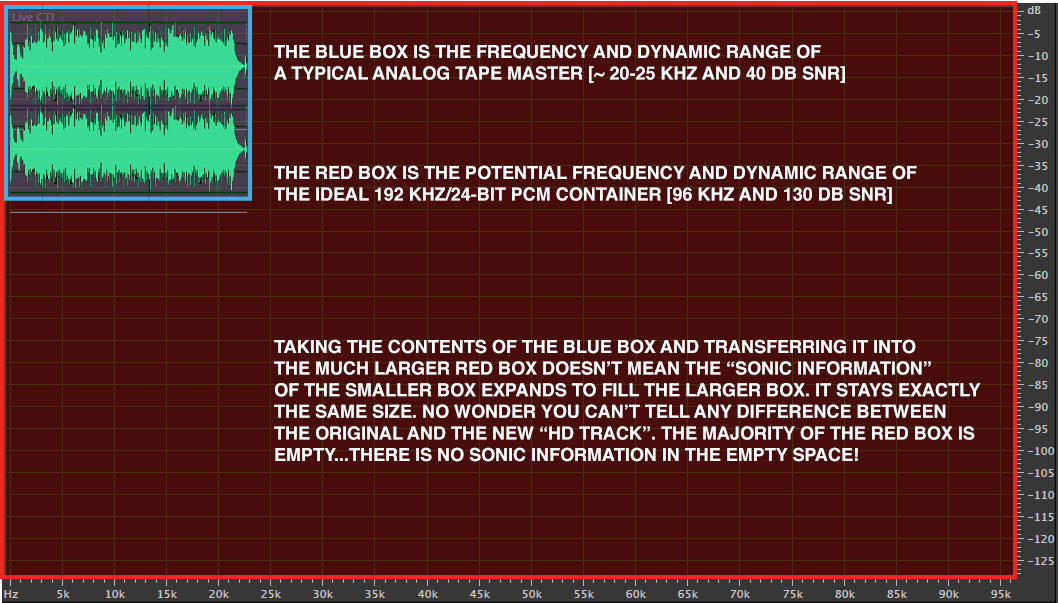The Whole Truth and Nothing But The Truth – Part II
This is the second part of a post that started yesterday. I’m talking about some of the “marketing spin” that websites use to make their offering more compelling. I took the following line from the About HDTracks site.
“An HDtracks Master Quality file is typically either 96kHz/24-bit or 192kHz/24-bit, meaning that it has twice the bit depth of your favorite CD and up to 9612Kbps of sonic information!”
This one is particularly challenging to parse. When you begin to use specifications and technical terminology, things can quickly get fuzzy very quickly. I know I use numbers and charts a lot on this website. I understand the temptation to avoid the specifications that make your stuff look inferior and focus on the positive stuff.
Laura Sydell of NPR asked me several times if claim that DSD 64 files have 64 times the resolution of a CD was true? I said it was absolutely false. I tried to explain that standard DSD encoding uses a sample rate of 2.8224 MHz, which IS 64 times the sampling rate of a compact disc BUT that those numbers don’t mean anything if you don’t take into consideration the word lengths of each sample. It is necessary to understand the basics of DSD and PCM. Given the number of times she asked me about this, I don’t think she every really understood.
So let’s look at what HDTracks’ sentence is saying. The mastering facilities that they work with are delivering “96 kHz/24-bit or 192 kHz/24-bit” stereo PCM files to the HDTracks servers. However, unless I’ve got my math wrong…24-bits is NOT “twice the bit depth of your favorite CD”, which is 16-bits. If we do the math correctly, the actual relationship is 33% more information…or I should say potentially more. It only matters if the master that is being transferred uses 24-bits. We know that virtually ALL commercial releases don’t.
Figure 1 – A chart showing the bitrates associated with some common audio specifications.
Here’s how you get the 9216 kbps number (Actually, the number on the HDTracks site is wrong…it should be 9216…they mistyped 9612). Simply take the sample rate times the number of channels times the number of bits and presto you get a really big number. It’s a whole lot bigger than the measly 128 kbps you get with most digital download stores, right? So it must be 75,000 times better than your average music file from iTunes. This is numeric double speak.
First, HDTracks can only tell you what the size of the delivery container they’re offering you. And the maximum size of that container is a 192 kHz/24-bit stereo PCM file. But unfortunately it’s not full of “sonic information” as they claim. It’s mostly full of empty bits. Bits that you’re paying a premium price for.
The reason is because the source file that the folks at the mastering facilities are using doesn’t have enough “sonic information” to fill up the new over-sized container! A third generation “EQ’d master analog tape needs only 6-10-bits of dynamic range and doesn’t extend past 17-20 kHz…and sometimes much less. Take a look at Figure 2 below.
Figure 2 – A graphic showing the size of a source file and the delivery container you’re paying for. Is this real HD-Audio? (Click to enlarge)
What I would like to see is a serious effort on the part of labels, download services and music industry folks to be transparent with regards to their marketing messages. I know if it will happen but we can write and call the companies that are doing it and let them know we not going to take it anymore!
When I get my book completed, at least there will be a place that confused consumers can go to get information without so much hype.




Apparently there is a hunger for high resolution music but there is a limited supply. So everything is lapped up. If the supply is increased, those who do not publish the recording chain will slowly die. Does HD Tracks have exclusive licensing deals with the big labels? Why not you or somebody else make similar deals with the big labels and clearly mention the recording & mastering chain. Then stores like HDTracks will either die or open up.
Linn Records is another mystery store. They sell 192/24 music but don’t usually state the origins (correct me if I am wrong). Many of their SACDs use HDCD on the CD layer. This makes me believe that they record in PCM. But their 192/24 downloads often have DSD like noise. So do they convert PCM to DSD to release as SACD & then rip the SACD to 192/24 and offer it as a download?
Andrew
Writing about Linn records , my favorite Linn title is Dawn Langstroth: Highwire There appears to be musical information all the way to the limit of a 96kHz recording although my favorite track New York unfortunately has a -50dB tone @ 29.4
Andrew.
I’ve explained this to people using a film analogy:
Imagine a single frame of an 8mm home movie your dad shot back in the 1960s. Now imagine that one of today’s best film scanners imaged that frame at 5,000 or even 10,000 pixels per inch, resulting in a remarkably high-resolution scan. If you displayed that scan on an HDTV, would the image be high-def? Would the image ever have more information and detail than the original?
Nope.
Thanks Drew, I’ve used this one too.
Excellent analogy. I teach digital audio and this is an easy one to get your head around. If you want true outstanding HD video, or 4K video, you have to get something like a RED or an Arri Alexa – something that fills the frame with real and plentiful pixels but also can actually capture and resolve that much detail. Watching an iPhone video in 1080 can be useful but it’s not the same as Game of Thrones.
I believe your 9/26 post has an error in one of the figures
Your Figure 2 A graphic showing the size of a source file and the delivery container you’re paying for. What you’re showing looks like a sound intensity versus time chart, not a spectral plot of a master tape. I seriously doubt any analog master has flat spectral content all the way up to near 20khz.
The point you’re trying to make, though, is spot on. You’re telling it like it is about HD audio (if that’s what we’re calling it), and I have been enjoying your posts very much. I have a number of AIX records and they’re great.
Thanks very much for writing this up. I’ve become very discouraged about (a) the lack of honesty with which so-called high resolution music is sold, and (b) the tendency to kill the messenger, rather than address these very real problems. After about 3 years dabbling in this “hobby,” it seems to me it is rife with consumer fraud. Teaching people some techniques that amount to basic intellectual self-defense can only be a good thing, and I encourage you to do so.